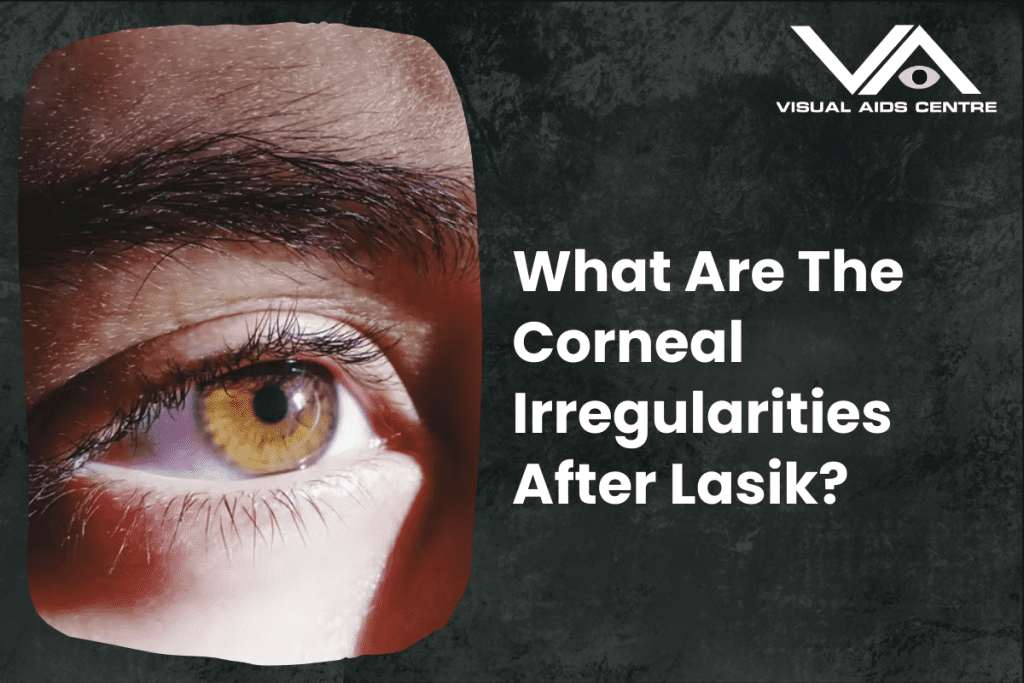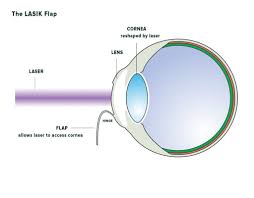Table of Contents
ToggleCorneal irregularities after LASIK are unexpected alterations in the cornea’s shape or surface that may affect visual outcomes or lead to post-operative complications.
Although LASIK is generally safe and effective, understanding these irregularities can help patients manage expectations and seek timely solutions.

Understanding Corneal Irregularities Post-LASIK
The cornea is a transparent, dome-shaped part of the eye responsible for refracting light onto the retina. LASIK (Laser-Assisted in Situ Keratomileusis) reshapes the cornea using a laser to correct refractive errors like myopia, hyperopia, or astigmatism. While this procedure offers excellent visual improvement for most patients, some may experience irregularities in corneal structure post-surgery, impacting vision quality.
How Do Corneal Irregularities Occur?
Corneal irregularities after LASIK occur due to the surgical process altering the corneal tissue. Factors such as the extent of tissue removal, individual healing response, or pre-existing corneal conditions may contribute to these irregularities. Identifying and understanding these issues is vital for effective treatment and post-operative care.
Types of Corneal Irregularities After LASIK
Each patient’s eyes respond differently to LASIK surgery. Below are the common types of corneal irregularities reported post-surgery:
1. Higher-Order Aberrations (HOAs)
HOAs are subtle visual distortions caused by microscopic irregularities on the corneal surface. Unlike lower-order aberrations (e.g., nearsightedness or farsightedness), HOAs are not correctable with glasses or standard contact lenses.
- Common Symptoms: Patients with HOAs may experience glare, halos around lights, starbursts, or reduced contrast sensitivity, particularly noticeable at night.
- Causes: The laser reshaping process may unintentionally create unevenness on the corneal surface, leading to these imperfections.
2. Ectasia
Corneal ectasia is a rare but serious complication. It occurs when the cornea becomes excessively thin and bulges outward, mimicking a condition similar to keratoconus.
- Symptoms: Ectasia can result in progressive visual decline, double vision, or significant astigmatism.
- Risk Factors: Patients with thinner corneas, high myopia, or pre-existing corneal weakness are more susceptible. Improper pre-surgical screening is a contributing factor.
3. Dry Eye Syndrome
While dry eye syndrome isn’t a structural irregularity, it can exacerbate irregularities by impacting corneal healing.
- Symptoms: Burning, irritation, grittiness, and fluctuating vision are hallmarks of dry eyes.
- Causes: LASIK temporarily disrupts corneal nerves, reducing tear production, which may lead to irregular healing and surface issues.
4. Decentered Ablation
A decentered ablation refers to an uneven application of the laser on the cornea, resulting in an asymmetrical corneal shape.
- Symptoms: Patients may report double vision, visual distortions, or poor night vision.
- Causes: Factors such as patient movement during the procedure or inaccuracies in eye-tracking technology may contribute.
5. Flap Complications
The creation of a corneal flap is a critical step in LASIK surgery, and errors during this process can cause irregularities.
- Types of Flap Issues:
- Incomplete Flap: When the flap is not fully formed.
- Buttonhole Flap: A hole or tear in the flap.
- Displaced Flap: Movement of the flap post-surgery.
- Symptoms: Visual distortions, discomfort, or delayed healing may occur.
6. Post-Surgical Scarring (Haze)
Corneal haze involves scarring or clouding of the cornea, which can impair clarity.
- Symptoms: Mild haze may go unnoticed, but severe cases can cause blurred vision or light sensitivity.
- Causes: Excessive healing response or inadequate post-operative care contributes to corneal haze.
Why Do Corneal Irregularities Matter?
Corneal irregularities can directly affect visual outcomes after LASIK. While many issues resolve over time with appropriate care, untreated or severe cases may lead to long-term problems. Understanding the potential risks reinforces the importance of proper pre-operative screening and selecting reputable surgeons.
Diagnosing Corneal Irregularities After LASIK
Detecting corneal irregularities requires specialised diagnostic tools and techniques. Here’s how an ophthalmologist assesses the post-LASIK cornea:
1. Corneal Topography
This imaging technique maps the corneal surface, highlighting any abnormalities in curvature or shape. It’s particularly useful for detecting ectasia or decentered ablations.
2. Wavefront Analysis
Wavefront technology evaluates higher-order aberrations, offering a detailed analysis of refractive imperfections.
3. Pachymetry
Pachymetry measurements determine corneal thickness to identify thinning, which is critical for assessing ectasia risk.
4. Slit Lamp Examination
A slit-lamp microscope allows the ophthalmologist to examine flap integrity and detect scarring or haze.
Managing Corneal Irregularities
The good news is that most corneal irregularities are manageable, and treatment options continue to advance. Here’s an overview of common management strategies:
1. Specialised Contact Lenses
Rigid gas-permeable (RGP) or scleral lenses can address irregularities by creating a smooth refractive surface over the cornea. These lenses are often prescribed for HOAs or ectasia.
2. Corneal Cross-Linking (CXL)
CXL is a minimally invasive procedure used to halt the progression of ectasia by strengthening corneal fibres with riboflavin drops and ultraviolet light.
3. Medications and Eye Drops
Artificial tears or prescription drops can reduce dry eye symptoms. Anti-inflammatory medications may be used to minimise scarring or haze.
4. Enhancement Surgery
Enhancement procedures, like a LASIK retreatment, may be performed to correct residual refractive errors or decentered ablations. However, patients should wait until their vision stabilises and corneal health is optimal.
5. Corneal Transplant
Severe cases of ectasia that do not respond to less invasive treatments may require a corneal transplant, although this is extremely rare.
Preventing Corneal Irregularities Before LASIK
While not all irregularities are avoidable, several steps can reduce the risk:
- Choose an Experienced Surgeon: Select a board-certified ophthalmologist with a strong track record in LASIK procedures.
- Ensure Comprehensive Pre-Screening: Proper baseline assessments, including corneal topography and pachymetry, are essential.
- Follow Post-Operative Instructions: Complying with post-surgical care guidelines ensures proper healing.
- Report Symptoms Promptly: Early detection and intervention are key to managing complications effectively.
When to Reach Out to a Specialist?
If you notice persistent visual disturbances, discomfort, or other unusual symptoms after LASIK, don’t delay contacting your eye surgeon. Timely diagnosis and treatment typically yield the best outcomes.
Final Thoughts on Corneal Irregularities After LASIK
Corneal irregularities after LASIK may sound concerning, but they’re relatively rare and often manageable. Proper surgical planning, advanced technology, and skilled ophthalmologists minimise these risks significantly. If you’re considering LASIK or are currently experiencing post-operative complications, consulting with an experienced eye care professional can help you achieve safe and effective vision correction.
By staying informed and seeking the right care, you can make your LASIK experience both rewarding and successful.













